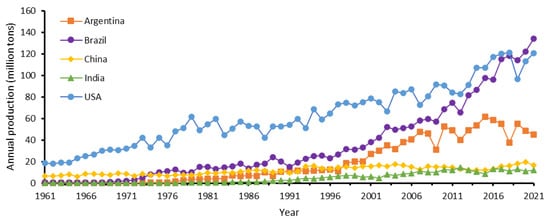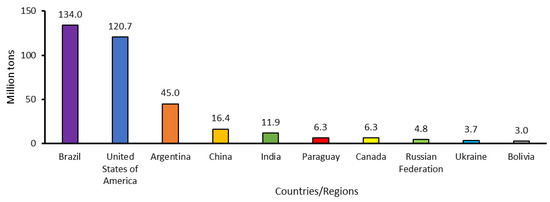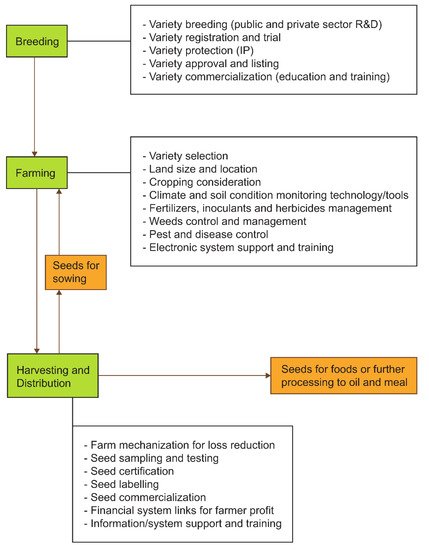Soybean is an important and valuable crop for global food and feed supply, providing high-quality nutrition. Globally, five countries—namely Brazil, the USA, Argentina, China and India—have dominated soybean production for many years. The aim of this review is to compare and contrast the factors impacting soybean seed production in these top five soybean-producing countries, including the situations at different stages of the supply chain; research and development on new soybean varieties; and regulations, rules and quality assurance systems (seed testing, certification and labeling).
- soybean
- seed standard
- seed certification
- seed law
- cultivar registration
1. Introduction


2. Factors Impacting Soybean Production and Supply Chain

3. Rules and Regulations for Seed Quality Assurance
|
The USA |
China |
Argentina |
Brazil |
India |
|
|---|---|---|---|---|---|
|
Seed Law |
Federal Seed Act [40] |
PRC Seed Law [41] |
Law No. 20247/73 on Seed and Phytogenetic Creations [42] |
LAW No. 10.711 [43] |
Seed Bill [44] |
|
Initial Promulgation Year |
1940 |
2000 (amended in 2021) |
1973 |
1978 |
1966 |
|
Central Governing |
USDA AMS |
MARA NATESC |
MAGyP, INASE, CONASE |
MAPA, Consultative Seeds and Seedlings Commissions |
Ministry of Agriculture and Farmers Welfare, Central Seed Committee |
|
New variety R&D Public Sector |
USDA, State Agricultural Experiment Stations |
Nanjing Agricultural University, CAAS, HAAS, etc. |
CONICET, INTA, Universities |
Embrapa |
ICAR, IISR |
|
New Variety R&D Private Sector |
Corteva Agrisciences |
Shandong Shofine Seeds Technology Co., Beidahuang Kenfeng Seed Co., Syngenta |
ADM, Criadero Santa Rosa, others |
SLC Agricola, AMAGGI, BOM FUTURO, Terra Santa, others |
Krishidhan Seeds Pvt. Ltd., Eagle Seeds, Bombay Super Hybrid Seeds Limited |
|
National Variety Registration and List (IP Protection) |
National list based on Plant Variety Protection certification database, plant patents, utility patents |
National list based on Regulation of Protection of New Varieties of Plants and Measures |
National Catalog of Cultivars based on National Register of Cultivars on Article 9 of seed law, National Register of Cultivar Ownership |
National registration of Seeds and Seedlings (RENASEM), National Registration of Cultivars (RNC), National Registry of Registered Cultivars (CNCR), Plant Variety Protection Law No. 9.456 |
National Register of Seeds, The Protection of Plant Varieties and Farmer’s Rights Act |
|
Rewards for New Variety Developed |
No |
Yes |
Yes |
No |
Yes |
|
Seed Classification |
Breeder, Foundation, Registered, Certified |
Breeder’s original seeds, Breeder’s seeds, Pure-breed seeds, Certified seeds, |
Original (basic or initial), Certified (Registered) 1st propagation, Certified subsequent propagation 2 and 3, Identified certified |
Basic, 1st generation certified C1, 2nd generation certified C2, Supervised S1 and S2 |
Breeder, Foundation Stage I, Foundation Stage II, Certified |
|
Seed Testing Methods |
AOSCA, ISTA |
GB 3543 Rules for agricultural seed testing (based on ISTA rule 1993) |
OECD, ISTA, AOSCA, National Inspection for Exclusive Export Destination |
OECD, AOSCA, ISTA |
OECD, ISTA |
|
Seed Certification Standards |
Seed law of each state varies. General seed and specific standards for soybeans applied. |
GB 4404.2 Seed of food crops—part 2: Legume |
The Resolutions of the Secretary of Agriculture, Livestock and Fish of Argentina N°2270-93 Tolerances for soybean seed and other species. |
MAPA in Normative Instruction No. 45, 17 December 2013 ANNEX XXIII Standards for the production and marketing of soybean seeds (Glycine Max L.), general and specifics. |
INDIAN min seed certification standards (general and specific) |
|
Seed Testing Technician Certification |
Certified Seed Analyst (AOS) Certified Seed Technologist (SCST) |
List of qualified Agricultural Seed Inspectors |
List of Accredited Inspectors |
Accredited Technicians |
Accredited Seed Analysts |
|
Seed Testing Labs Certification |
OECD Accreditation Program 46 AOSCA seed certifying agency USDA ASL 7 ISTA-accredited labs |
2 ISTA-accredited labs Seed quality testing agency approved by MARA |
1 ISTA-accredited lab (The Central Laboratory for Seed Analysis) |
2 ISTA-accredited labs List of seed and seed analysis labs accredited in RENASEM |
6 ISTA-accredited labs Central and state seed testing laboratory |
|
Seed Certification Body |
AOSCA, ISTA, OECD |
MARA-approved Crop Seed Quality Testing Institutions |
INASE |
MAPA and its accredited legal entities |
State Seed Certification Agencies appointed by Central Seed Committee |
|
Certification System |
OECD Seed Schemes (Soybean) AOSCA system Federal Seed Analysis Certificates |
State standard (GB) enforced by competent agriculture and forestry departments |
OECD Seed Scheme (Soybean) AOSCA system National Inspection system with Exclusive Export Destination |
OECD Seed Scheme (Soybean) AOSCA system |
OECD Seed Schemes (Soybean) ISTA Certification |
|
Seed Label Contents |
Variety and kind, Net weight, % Germination, % Purity, % Dormant or hard seeds, % Inert matter, % Other crop seed, % Weed seed, Name of noxious weeds, Lot number, Origin, Test date, Name/Address, Tag color for quality |
Variety and kind, Net weight, % Germination, % Purity, % Moisture, Variety registration number, Standards applied, Suitable planting area and season, License number, Test date and expiration period |
Cultivar Name (common and botanical name), Net contents, % Germination, % Purity, % Weeds, Seed classification, Name/Address, Registration number of the certifier and seller, Harvest year |
Cultivar Name and category, Net weight, % Germination, % Purity, Seed classification, Information required by specific standards Batch number, Name/address and registration number of the seed producer, Validity month/year of the germination test |
Name and variety, Net contents, % Germination, % Purity, % Inert matter, Seed classification, Lot number, Name/Address of producing institution, Date of test, Tag color for quality |
|
Label Governing Body |
USDA AMS |
MARA supervision and spot check of agricultural seed quality |
INASE |
MAPA |
DA&FW, Central Seed Certification Board |
|
Label Regulation |
Federal Seed Act, relative regulations, state seed laws |
General directive |
The Law of Seeds and Phylogenetic Creations No. 20247 /73 and its Regulatory Decree No. 2183/91. |
DECREE No. 5153, OF 23 July 2004 |
Seed Rule 1968 PART V—Marking or Labelling |
This entry is adapted from the peer-reviewed paper 10.3390/agriculture12050624
